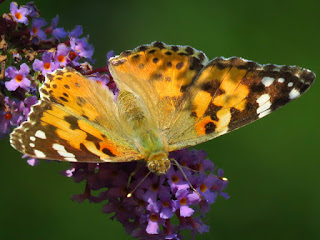Priorslee Lake: 04:15 – 06:00 // 06:55 – 09:20
The Flash: 06:05 – 06:50
15.0°C > 16.0°C: Area of medium cloud moved away to S leaving it clear if hazy. Low cloud / mist in vicinity later. Light and variable wind. Mainly good visibility.
Sunrise: 05:29 BST
Priorslee Lake: 04:15 – 06:00 // 06:55 – 09:20
(189th visit of the year)
Bird notes from today
- Two Tufted Ducks on the water at 04:50. Not seen thereafter.
- In addition to the usual resident Great Crested Grebes a new and obviously fledged well-grown juvenile was present
- A Hobby flew N at 07:00 causing consternation among the Barn Swallows and flushing all the Black-headed Gulls on the football field.
- A single Swift shot over at 05:55. All records after the end of July are worth recording as many birds have already left.
- Still no corvids passing early. They must be feeding elsewhere at the moment. A single Jackdaw later.
- No fewer than five Coal Tits logged with four of them in song. Unusually high number.
- Today’s Pied Wagtail count on the football field at 09:15 was just 11 birds, though several of these had only just flown in. Perhaps more were on the way (from where?).
Bird totals:
Birds noted flying over or flying near the lake:
- 4 Greylag Geese (all outbound)
- 27 Canada Geese (again: today in 5 separate groups outbound)
- 1 Hobby again
- 3 Stock Doves
- 156 Wood Pigeons
- 1 Jackdaw
- no Rooks again
Hirundines etc. noted:
- 1 Swift
- 12 Barn Swallows
- 6 House Martins
Warblers noted (singing birds):
multiple feeding groups: accurate numbers hard to ascertain
- 13 (2) Chiffchaffs
- 3 (1) Willow Warbler
- 5 (0) Blackcaps
- 5 (0) Common Whitethroats
- 3 (0) Sedge Warblers
- 9 (1) Reed Warblers
Counts from the lake area:
- 2 + 6 (1 brood) Mute Swans
- 1 Greylag Goose (throughout)
- 4 Canada Geese (arrived and departed)
- 11 (?♂) Mallard
- 2 (?♂) Tufted Duck (departed)
- 1 Grey Heron
- 6 + 4 (3 broods) Great Crested Grebes
- 4 Moorhens (un-aged)
- 41 adult and juvenile Coots: also both small juveniles from the newest brood
- 1 Common Tern (arrived)
- 33 Black-headed Gulls (1 juvenile)
- 1 Kingfisher
On the lamp poles pre-dawn:
- 1 Common Plume moth (Emmelina monodactyla)
- 1 Single-dotted Wave moth (Idaea dimidiata)
- 1 Dun-bar moth (Cosmia trapezina)
- 4 Common Green Lacewings (Chrysoperia carnea)
The following logged later:
- Butterflies (in species order : no totals)
- Speckled Wood (Pararge aegeria)
- Meadow Brown (Maniola jurtina)
- Gatekeeper (Pyronia tithonus)
- Painted Lady (Vanessa cardui)
- Peacock (Aglais io)
- Moths (in species order):
- 1 Olive Pearl (Udea olivalis)
- many unidentified grass moths
- Damselflies etc:
Despite an obvious recent hatch with larvae cases all over the sluice exit platform there were very few flying around: only Common Blue Damselflies noted
- Hoverflies:
- <<to be supplied>>
And other things:
- many Honey Bees again (Apis mellifera)
- 3+ White-tailed Bumblebees (Bombus lucorum)
- 1 pipistrelle-type bat
- 1 Grey Squirrel: the same eating Hazel nuts?
A calm morning with a hint of mist and rather hazy
A juvenile Long-tailed Tit having moulted at least some of its first and very downy feathers.
Not a very helpful angle. The extensive brown in the wing identify this as a Common Whitethroat.
A perky Sedge Warbler showing its obvious wide creamy supercilium.
With a twig across its face – but we can see the hint of a pale crown stripe from this angle.
A crisp image (for once) of the underside of a Meadow Brown butterfly (Maniola jurtina)
The upper side of a female Gatekeeper butterfly (Pyronia tithonus) ....
.... and a rather battle-scarred male. Only males show the dark are in the centre of the forewing.
A bumper year for this species this year – a Painted Lady butterfly (Vanessa cardui)
(Ed Wilson)
------------------------------------------------------------------------------------------------------
The Flash: 06:05 – 06:50
(182nd visit of the year)
Notes from here:
- I think we must assume the cygnets have perished.
- Many of the Mallard seen (and probably many more unseen) were tucked away inside the island and impossible to sex: logged as ‘not drakes’.
- Five Cormorants circled around as if about to land. If they did so they were behind the island for me. I did not see them again.
- A group of 6 Stock Doves together overhead was unusual.
and, moth on a lamp pole
- 1 Little Grey (Eudonia lacustrata).
Birds noted flying over / near The Flash:
- 6 Stock Doves
- 4 Wood Pigeons
Hirundines etc. noted:
- 4 House Martins
Warblers noted (singing birds):
- 3 (1) Chiffchaffs
- 1 (1) Willow Warbler
- 1 (0) Blackcap
Counts from the water:
- 3 Mute Swans again
- 17 Greylag Geese
- 20 Canada Geese
- 20 (>7♂) Mallard
- 24 (16♂) Tufted Ducks
- 5 Cormorants
- 1 Grey Heron
- 2 + 2 (1 brood) Great Crested Grebes
- 3 + 1 (1 brood) Moorhens again
- 16 + 4 (2? broods) Coots
- no Black-headed Gulls
- 1 Kingfisher
(Ed Wilson)
------------------------------------------------------------------------------------------------------
Between the lake and The Flash:
- Moorhen(s) heard at both pools: sounded like very new juveniles at the lower pool.
- 1 Great Spotted Woodpecker near each pool.
and
- 1 pug moth on the roof of the Priorslee Avenue tunnel.
(Ed Wilson)
------------------------------------------------------------------------------------------------------
On this day..........
2017
Priorslee Lake
Today's Sightings Here
2012
Priorslee Lake
Common Sandpiper
(Ed Wilson)
2005
Priorslee Lake
4 Common Tern
Yellow Wagtail
(Ed Wilson)
Priorslee Lake
Today's Sightings Here
2012
Priorslee Lake
Common Sandpiper
(Ed Wilson)
2005
Priorslee Lake
4 Common Tern
Yellow Wagtail
(Ed Wilson)




















